Sorry, but you’re making bacon wrong
Stovetop, oven, microwave — what’s the best way to cook bacon?
Recommendations are independently chosen by Reviewed's editors. Purchases made through the links below may earn us and our publishing partners a commission. Prices were accurate at the time this article was published but may change over time.
Pretty much everyone on planet Earth is a lover of the greasy meat strips we call bacon. Even vegetarians can’t resist some good old vegetarian bacon. Our VP of Product Development, Sunil Doshi, even said, “I was vegetarian for 10 years and bacon was one of the evil things that pulled me back in.” Whether you like turkey bacon, vegetarian bacon, or classic pork bacon, the real question is—what is the best way to cook it?
Here at Reviewed we've tried a few different contraptions to cook bacon, from a bacon toaster to a 3-in-1 breakfast station. However, most people don’t have those products in their home — but everyone has a microwave, oven, and stovetop. While most people opt for one of these methods, we wanted to take it a step further and find out what the best way to cook bacon was. Which way was the ultimate winner? I dove into a vat of bacon fat to find out.
The Bacon Games
One morning, there I was, alone in my kitchen with 3 packages of Oscar Meyer bacon. My mission: to find out which method of cooking bacon was superior. I wanted to do this as scientifically as possible, so I kept a few constants throughout my testings. I used the same type of bacon and the same amount throughout all 3 methods (10 slices of Oscar Meyer bacon). I also timed each method — starting from the very beginning, before any pre-heating or prep of any kind.
I took into consideration 4 factors:
- Ease of use: how easy it would be for me to make this in a half-asleep stupor on a weekend morning
- Grease: How much it accumulated throughout the cooking process
- Cleanup: Let’s be real, we are all lazy and nobody enjoys doing the dishes after cooking
- Taste: encompassing all things that make bacon bacon: flavor, texture and crispiness
Cooking bacon in the microwave
First up came the microwave. I figured this wouldn’t do great, since only 1 person in the office voted for this as the preferred method of cooking (hi Lee!). I followed the standard method of 2 paper towels down on a microwave-safe plate, then 3-4 slices of raw bacon, then another 2 paper towels on top. Pop it in the microwave for 4 minutes and….
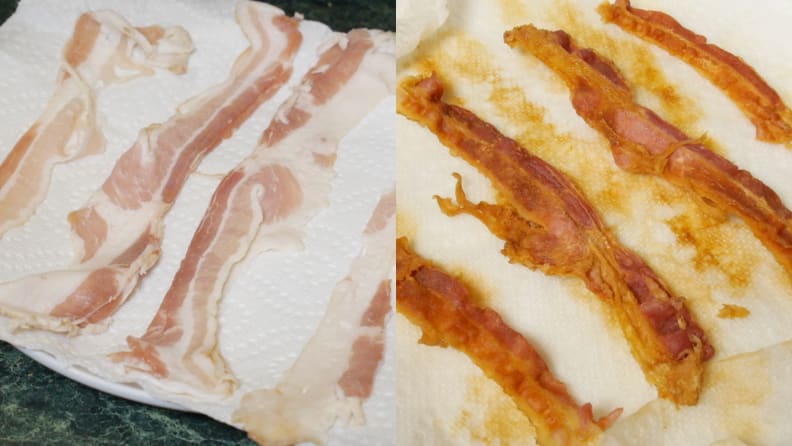
Bacon made in the microwave was dried out.
It was the saddest bacon I’ve seen since Kevin Bacon himself (no offense, Kev). It was hard and overcooked so much so that it was brittle to the touch. The next batch, I tried cooking it for only 3 minutes and yet when I took it out of the microwave — it was hard but still raw? Unsure how this was possible, I popped it back in for another minute and it came out edible and similar to the first one. Finally I ended up at 3:30 minutes and it seemed to be the sweet spot, not too hard or overcooked, although it was still brittle and stuck to the paper towels. Not a great start to my morning.
Cooking bacon in the oven
Next up, I went for the oven. I pre-heated it to 400 degrees , lined a sheet with tinfoil (to make cleanup easier — as recommended by food gurus), and laid out my 10 strips beautifully. By the time I had the bacon all set up on the baking sheet, the oven was preheated so I popped them in and ignored them for 18 minutes. I checked in around 12 minutes and they seemed to be pretty crispy, and since I’m not one for charcoal-like bacon, I pulled them out.
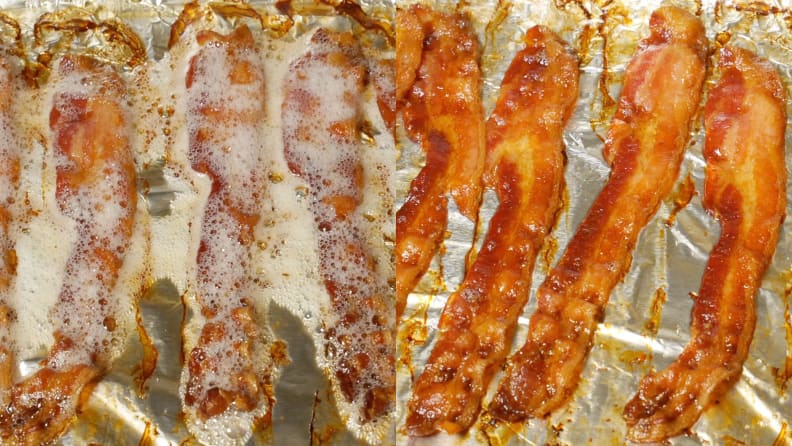
Cooking bacon in the oven left is covered in grease, but it tasted so good.
These bacon strips were pretty greasy. It was satisfying to see them still cooking in their own grease right in front of your eyes but it also was kind of gross to know you’d be eating that in a short period of time. The recipe I was following said to pat the remaining grease off and several paper towels later, I could see the bacon strips! They were long and luscious, crispy but not too crunchy, still bendable without breaking — just how I liked them. I ate a few pieces before remembering the grease... then ate one more piece and moved onto the next test.
Cooking bacon on the stove
Finally there was the stove-top method. In our office poll of preferred methods of cooking bacon, this was the most popular method by far. 19 people voted for stove-top while only 6 voted for oven. I went in excited to try this method and I was surprised by how much I hated it. The recipes I found online said to use the bacon’s own fat to cook itself, but when you’re first starting out and there’s no bacon fat — just raw bacon slices in a frying pan — it burns. The first 4 pieces I made burnt badly and it was hard to find a temperature that still let the bacon cook, but didn’t have grease splattering everywhere.
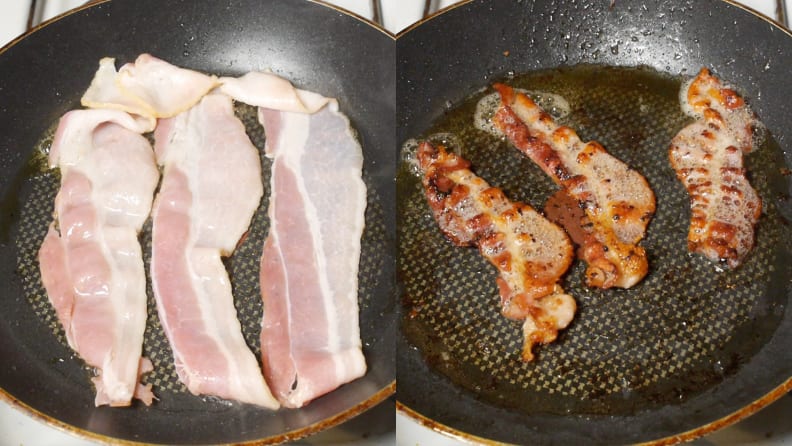
The stove-top method shrunk the bacon up and burned it a little.
When it was finally all said and done, it seemed like I had less bacon than I started with. It took almost as long as the oven method to do and the frying pan method really shrunk up the bacon slices. This made the surface area of the bacon see smaller — getting less ba(co)ng for your buck. It was also hard to find the fine line between overcooked/burnt and undercooked/raw. Plus, none of the other methods hurt but with this one; I found myself wearing long sleeves in the middle of summer just to avoid the splatter of grease.
This is how you should be cooking bacon
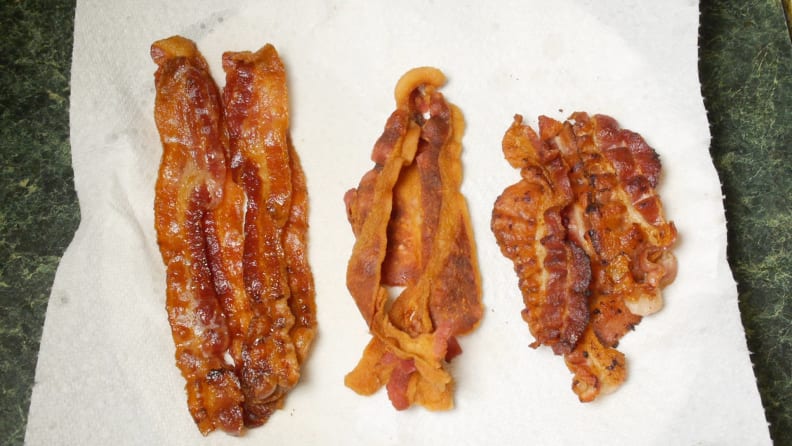
From the left this is bacon cooked in the oven, microwave, and on the stovetop. See the differences?
So despite popular opinion, stovetop isn’t worth the effort. It’s too much hard work to flip the bacon and keep the constant rotation of bacon in and out of the pan, while also making sure the bacon isn’t too raw or too cooked before you take it out. Microwave was predictably not the best for texture or actual taste, although it was the easiest overall. In the end, the best way to cook bacon was undoubtedly in the oven!
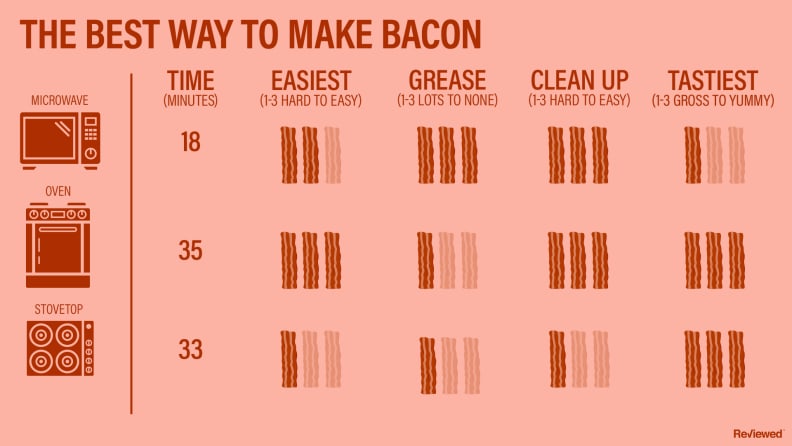
These are the results from my bacon tests where the oven method takes the cake.
As you can see from this nifty chart, the microwave had the least amount of grease and the easiest cleanup. This was probably due to having the paper towels incorporated into the cooking process. That being said, it also dried them out while cooking, which led them to taste the worst. Also, it was annoying to have to repeat the cooking process every four minutes and only make four pieces of bacon at a time. Overall, I’d avoid this method unless you're using bacon bits in a recipe—where you don't mind if its crispy little chunks that don't taste incredible on their own.
The stovetop was definitely the hardest one to make and the hardest for cleanup — as I type this now I still have yet to clean the pan I made the bacon in this morning (sorry roommates!). The high ratings might be misleading but most of them are negative. Out of all the methods, this was by far the greasiest and crunchiest. The bacon slices shriveled up a little so that it made the bacon smaller, but it still tasted good enough for me to give it a 3 in taste. However, since it was such a pain to actually cook the bacon, I wouldn’t bother with this method again.
Finally, you have the winner: the oven. It was the easiest method by far— just set and forget. Like the stovetop, it also had a lot of grease but it was easy to dab off the top. As far as cleanup, it wasn’t too bad with the tinfoil underneath but I did have to clean the sheet tray afterwards because bacon grease gets everywhere. As far as taste? It was delicious. It was crispy but not burnt, bendy, but not too chewy, and overall beautiful.



